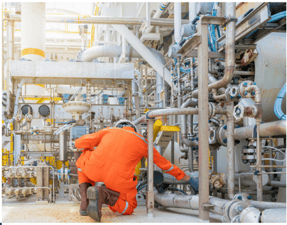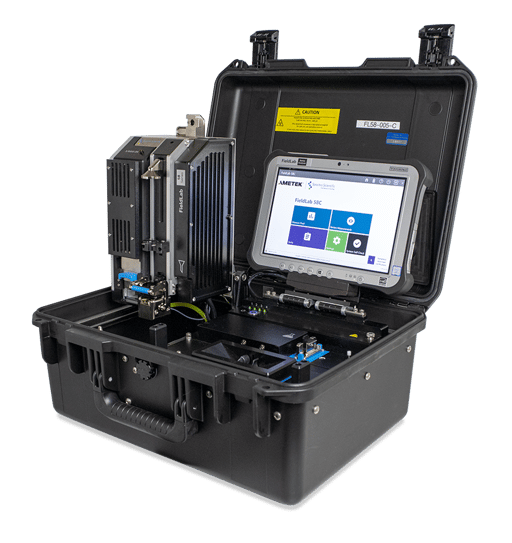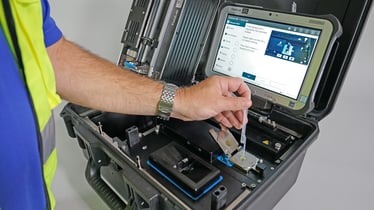Exploration Rigs insist on Oil Analysis
For many years, rig operators have used oil analysis as an essential tool for routine maintenance and future cost avoidance. On oil rigs, equipment failures risk employee safety, and missed production targets are realized very quickly. The remote locations of offshore rigs make routine maintenance very expensive. In most cases, skilled people and supplies can only reach the platform by ship or helicopter so the cost of bringing technical specialists, replacement equipment, spare parts and tools to the platform is high.

Considering this, oil analysis plays a critical role by alerting the maintenance team to problems that may damage a vital system. An effective oil analysis program also helps to efficiently allocate scarce resources by planning maintenance based on equipment condition rather than time intervals. Currently, most offshore platforms take oil samples and ship them by helicopter to onshore labs for analysis. Once the results are available, they are sent back to the platform.
Typical production platform costs:
It costs more than $1 billion to operate a typical production platform over its 10 to 20-year life cycle, so operating costs per day can be estimated at $100,000 to $300,000. A typical offshore platform contains millions of dollars of machinery that is critical to the crew’s safety and whose failure can easily put the platform out of operation. Oil analysis determines the amount of various metals in the oil, providing a fast and inexpensive way to gauge the amount of wear in the machinery. Oil analysis also helps determine the condition of the oil by measuring byproducts formed by oxidation and by measuring the viscosity. Monitoring oil condition reduces the risk of catastrophic failure and can also reduce the high cost of changing and disposing of oil in heavy machinery.
Typical equipment sampled by Oil Analysis flooded screw compressors:
- Flooded screw compressors
- Turbo gas powered generators
- Fire water pumps
- Diesel engines
- Gearboxes
- Pumps
- Crane engines
- Hydraulic systems
Challenges

The problem with this approach is it might take a week for the sample to reach the lab, another week for the lab to perform the analysis, another week to process the results and get them back to platform, and perhaps one more week before technicians view the results and take action. By the time the results are acted upon, the equipment may have failed. Combined with this delay, oil reports from onshore contract oil labs may lack the specific detailed diagnostics necessary to inform rig personnel to take actionable decisions. A recommendation to resample to confirm a problem is very frustrating to rig maintainers when received four weeks after the first sample, and leads to discounting oil analysis as an effective tool.
Value of oil analysis on offshore platforms
Recently, an offshore rig in the Gulf of Mexico reached out to a reliability services provider in Louisiana to seek a solution to improving their oil analysis program. The long turnaround time from their onshore lab compounded weaknesses of their current program.
Key issues to address:
- Frequent resamples due to mislabeling Collected samples from the various rotating equipment on the platform were misidentifed, leading to erroneous results by the contract lab. Policy demands action to CAUTION or ALERT status samples, so long delays caused operators to discard results.
- Missed Compressor failure A genuine problem detected by oil analysis on a failing air compressor was received one month after the compressor had failed without warning. The rig operator then incurred extra costs replacing it. It can cost $250K for expedited freight and installation charges alone to replace a critcal system ASAP.
- Resources for onsite oil analysis The rig operator had submitted their operating budget for 24 months to the oilfield license holder. They were not in a position to dedicate rig personnel to operating onsite oil analysis equipment in addition to sampling.
Solution Proposal
The oil producer asked the reliability service provider to travel to its platforms with a portable oil analyzer that was able to provide comprehensive analysis, providing immediate results and generating a full report with recommendations throughout the shift. The service provider proposed sending a Level III Vibration Analyst/Tribologist Service Engineer, who had all the necessary safety certifications for transport and was familar with rotating equipment and maintenance strategies on board the rig. The major challenge was to select a portable, solvent free oil testing device that could measure abnormal metals, viscosity, oil chemistry, and particles with the ability to provide a report. The solution chosen was the FieldLab system. 
It consists of four modules:
- Infrared spectrometer with flip top cell design; tests for Total Acid Number/Total Base Number, water content, soot, oxidation and new fluid validation.
- Kinematic viscometer determines viscosity without solvent and with a low sample volume.
- Filtration Particle Quantifier (FPQ) provides solvent-free counts per ml for > 4 μm particles.
- Elemental analysis module performs wear metal and sand/dirt analysis to identify abnormal wear and contamination ingress using X-ray Fluorescence (XRF) technology.
In this scenario, a technician flies by helicopter to offshore oil platforms with a portable instrument and performs the same tests offered by full-service laboratories. The portable instrument provides comparable accuracy as full-size laboratory instruments yet it fits into a backpack and is easily transported on a small helicopter. The all-in-one unit provides immediate oil analysis results. If there is an abnormal result, the platform personnel can act immediately to resolve the problem. Another key advantage of the portable analyzer is the ability to immediately re-check every positive result to ensure the initial test results are accurate. The retesting prevents false positives and allows substantial cost savings by avoiding unnecessary repairs or replacements.
Initial Examples
There have already been several cases where the savings from on-site oil analysis exceeded the full year’s cost of the service.
- For example, technicians on one platform replaced the diesel engine on a crane. When the technician visited the platform and tested the oil, the viscosity was 70 cSt when it should have been 120 cSt. The technician ran additional tests and discovered the presence of diesel fuel in the oil. A mechanic put dye in the fuel supply and found a broken injector line was leaking diesel fuel into the oil sump. This leak had the potential to damage the engine or even cause a fire. The oil analysis results made it possible to fix the problem with a low cost solution – replacement of the injector line.
- In another case, the oil analysis results on a large gas turbine compressor showed a high metal particle count. The technician queried the platform’s maintenance team and discovered they had recently replaced a valve in the lube oil system. The technician wondered whether the oil particle count might have spiked in response to this maintenance, so he flushed the lube system and ran another test. This time the test showed a much lower particle count although still above normal values. After discussing the situation with the maintenance foreman, the decision was made to do nothing immediately but to retest the equipment the following month. When the equipment was retested, the particle count had returned to normal levels. According to the maintenance foreman, if the oil had been tested by an onshore lab, there would have been no chance to do an immediate follow-up study. It would have been necessary to, at the minimum, perform vibration testing and possibly perform even more expensive repairs.
Data management and reporting
The results of offshore oil analysis can be uploaded to the TruVu 360 fluid intelligence system. The results are available not only to the maintenance team on the platform but to onshore managers and analysts who track trends and provide recommendations on whether or not to invest in a certain piece of equipment.
Summary
The current oil analysis method used on most offshore platforms takes up to a month to send samples to a lab and receive the results. On-site oil analysis has the potential to provide major value and benefits by allowing testing on the rig and delivering immediate answers to the maintenance team. Faster results can prevent breakdowns and avoid unnecessary maintenance. The savings are realized by the ability to get answers quickly and better manage equipment uptime on the offshore rig.



